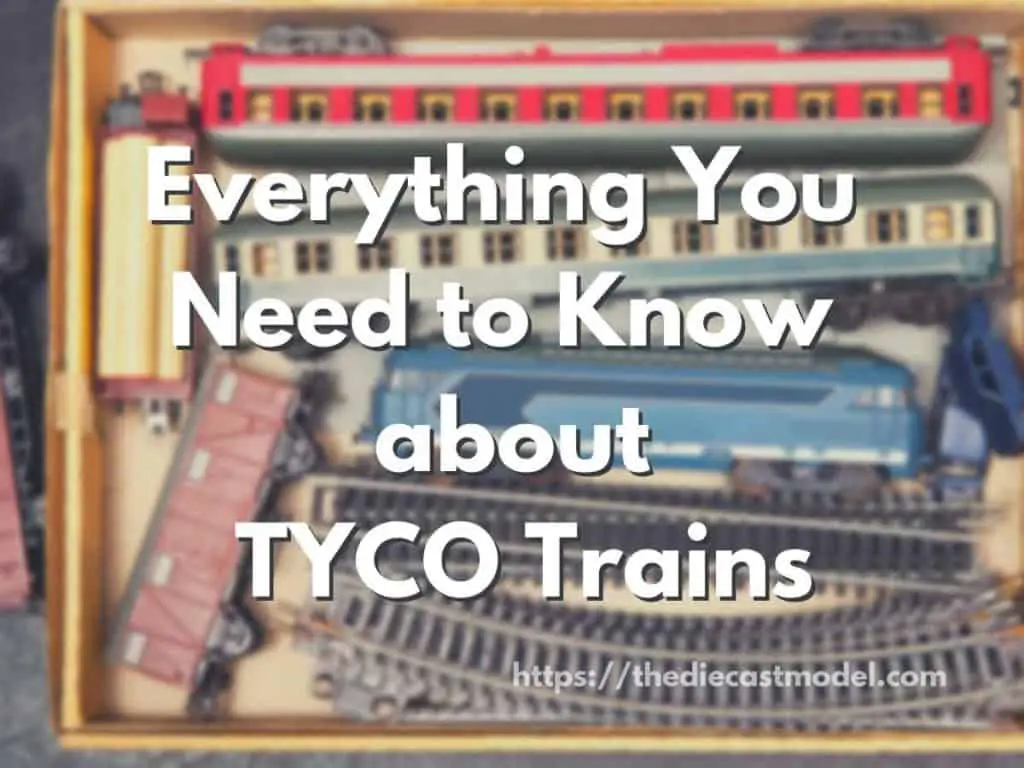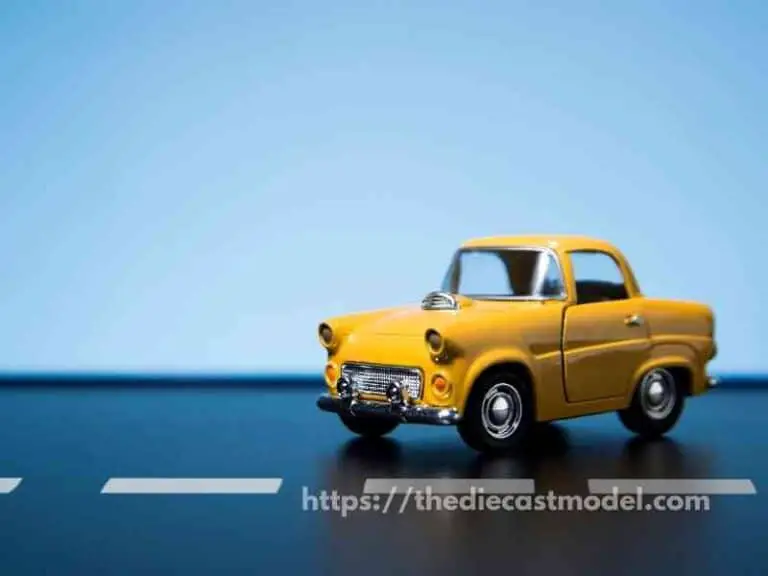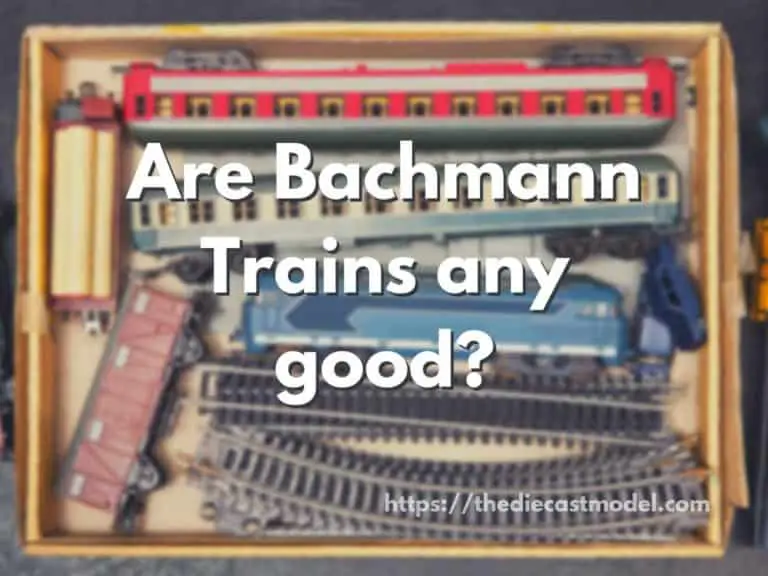TYCO Trains: Everything You Need to Know | History, Production, Value
You might probably remember the TYCO train brand being sold in toy stores. Sadly, this brand isn’t the Tyco security products and solutions around today. Tyco trains ended with its last catalog produced in 1993. But what caused this downfall? Can we still find these trains? How much can we get from selling these old train sets if you have some around? Let’s find those out in this post.
TYCO trains were a popular brand for model trains from 1952 to 1993. They are famous for their HO ready-to-run train sets, TYCO kits, and HO slot cars. TYCO trains aren’t being produced anymore. However, their train molds are being used by Lionel since 2018.
This post will discuss the history of TYCO trains. Their boxes era, how they became famous, their relationship with Mantua trains, their downfall, where they are today, and some rare Tyco train sets and their value.

Are TYCO HO trains any good?
TYCO trains that are made before 1970 are good and of high quality. This is because TYCO trains before 1970 are made by Mantua, which is a known high-end model train brand. However, due to being bought by Consolidated Foods, they started offering fantasy models instead of realistic models which lessened its appeal to hobbyists.
Sadly, being bought by Consolidated Foods removed TYCO train’s popularity among collectors, which is known to have produced realistic and high-quality models.
When Consolidated Foods bought the company, they started to offer trains that weren’t realistic. This is where they began to offer model trains such as Popsicle and StarKist Tuna box cars.
However, while this increased their sales in toy stores, this upset hobbyists and collectors since the brand are known to produce high-quality and realistic models.
What was known to produce high-quality model trains became someone who produced fantasy trains for toy stores.
Combine this with people losing interest in model trains, and TYCO started to decline and ended in 1993.
But how would we know if the models were made before 1970? Well, we need to check the box.
Generally speaking, TYCO model trains that are in their blue or red box are of good quality and expensive. However, TYCO model trains that are in their brown box tend to be less expensive since the ones in the brown box are produced when they switched their focus to unrealistic models.
But what are those blue and red boxes? Well, that’s when we have to talk about the history of TYCO trains.
TYCO trains started in 1952. However, they are already producing model trains for decades because they are a branch of Mantua trains.
Mantua trains were started in 1926 by a man named John Tyler. His son, Norman Tyler, became the president of TYCO trains.
The reason Mantua made TYCO trains is because they have seen a rise in interest in model train sets or ready to run (RTR) sets.
Mantua is known to have produced high-quality model trains, and their release of RTR sets from TYCO became a huge hit.
That’s why their first RTR sets are named TYCO-Mantua, and collectors know this as “the blue box era” for Tyco.
These models are called the blue box era because the sets are in a light blue box, which means that these models were made in the 1950s.
Recommended Read: If you are interested in knowing the history of Mantua trains, please check this post where I also gave Mantua’s history, quality, and worth: Everything you need to know about Mantua Trains.
In the 1960s, TYCO saw massive growth, and they expanded their lines to not only model trains but also slot cars.
In this era, they changed their box color to red. This is why TYCO models built in the 1960s are called “the red box era” for collectors.
These two are the golden years of TYCO. However, since the 1960s, the sales of model trains started to dwindle, with more people collecting other models such as spacecraft, plane, or car models.
That’s why in 1970, TYCO was bought by Consolidated Foods.
In 1970, dwindling sales in model trains started to hit TYCO, and they began to diversify and try to make model trains suitable for everyone.
That’s when they started to offer other lines such as “Super Blocks,” which is their version of LEGO. This was also when they diversified into RC cars, which Tyco is also known for.
This content was originally posted on thediecastmodel.com. If it appears on other websites, it is a violation of the copyright owned by thediecastmodel.com.
TYCO also made fantasy toy trains to increase its sales. However, while it increased sales, fans of TYCO started to hate this move and made them lose some loyal customers.
Collectors call the train models in the Consolidated Foods era the “Brown Box.”
Despite these moves, model train sales are still declining, making them stop their model train production in 1993.
However, while the company isn’t around anymore, its product molds are still being used and sold by other companies. We will discuss Tyco’s legacy in the next section.
Are TYCO trains still made?
TYCO trains are still being made by Lionel ever since they bought Mantua trains in 2018. In 2019, they started including HO Mantua trains in their catalog, which uses the molds used by TYCO trains. So while we can’t see the TYCO brand for model trains, their molds are still being used to make HO scale Lionel trains.
TYCO RC and slot cars were bought by Mattel in 1997. This is why their car models are being sold by Hot Wheels, which Mattel owns. However, you won’t see the name TYCO on these models. Instead, they are rebranded as Electric Hot Wheels.
Sadly, Tyco isn’t in business ever since other companies bought it. Their train brand is now being used by Lionel to produce HO scale trains, and their slot cars are bought by Mattel, which makes Hot Wheels.
So, while they aren’t around anymore, they left some legacy on some models we can find today.
Lionel’s urge to get into the HO scale market made them buy Mantua in 2018, which means they started to use TYCO’s molds in their new HO scale model trains.
Currently, these trains are being made in Vietnam.
If you remember the short history, Mantua owns Tyco, and since Lionel uses Mantua molds, that includes the molds used for TYCO.
Tyco car models such as the RC and slot cars were bought by Mattel in 1997. However, we won’t see TYCO on these models. Instead, they were rebranded into what most know as Electric Hot Wheels.
So, TYCO molds are used by other companies to this day.
However, it is worth noting that the Tyco Security Products and Solutions are not related to the old Tyco toys.
Recommended Read: Interested in knowing about Lionel and Mattel? Glady, I made a post about them which you can find here: Are Lionel Trains Worth it? | How to Tell if Hot Wheels is Valuable?
Are old TYCO train sets worth anything?
Generally speaking, old TYCO trains can be sold for $100-$500 depending on their age, rarity, and condition. Also, Tyco trains within the blue and red box era are more expensive than in the brown box era. Lastly, TYCO trains in mint condition are significantly more expensive than opened ones.
Remember that TYCO trains sold in their prime, which are in the 1950s and 1960s, are expensive, and you can see those with the color of their box.
An example is the 1960 TYCO HO Golden West Train set. This train set was produced in 1960, which means it is in its red box.
While the product is already used and not in mint condition, the age and box alone gave it a high value.
This train set was sold for $275 in an auction.
Another example is the 1974 Alco Super Action Freight Train set. While it is not as old as the 1960 TYCO Golden West, it is a rare model train set, which means it is produced in limited quantities.
Furthermore, this train set is still in excellent condition, so it was sold for $220.
But what if we have a mint in condition Tyco train set? Well, we can expect more value from them.
For example, an unopened 1987 Tyco Super Turbo Train set was sold for $500 in an auction. This model isn’t opened, and the box is well preserved. While this is a 1987 train set, it is still in mint condition for three decades is fascinating.
I have more examples of TYCO trains that were sold for hundreds.
For example, the 1985 TYCO Transformers G1 Electric Train set is sold in excellent condition for $299.
Another is the 1978 TYCO Chattanooga Choo Choo train set in excellent condition with accessories still working was sold for $280.
The current state of collecting TYCO trains
While I have given lots of examples of TYCO trains sold for hundreds of dollars, I can say that the current state of TYCO trains collecting isn’t going to be better in the future.
TYCO trains have not been around since 1993, and fewer people are collecting these trains than before.
Fewer people are collecting means less demand for these trains. Thus, while they can get extremely expensive due to age, rarity, and condition, their price wouldn’t increase much since fewer people are willing to buy them.
For example, some model trains from Lionel and Hornby, which has significantly more collectors than TYCO, can be sold for thousands of dollars. If you want to know more, you may check these posts: Lionel Train’s Worth | Hornby Train’s Worth
After reading those posts, you will understand what I mean and how big their price gap is.
Thus, if you have one lying in your basement, it would be good to sell them before their prices start to go down.
Don’t worry because I have a nice guide on how to sell these models.
What’s next? As promised, I made a complete guide on where and how to sell diecast models both offline and online. You can find my guide here: A Helpful Guide on Buying and Selling Diecast Models.






